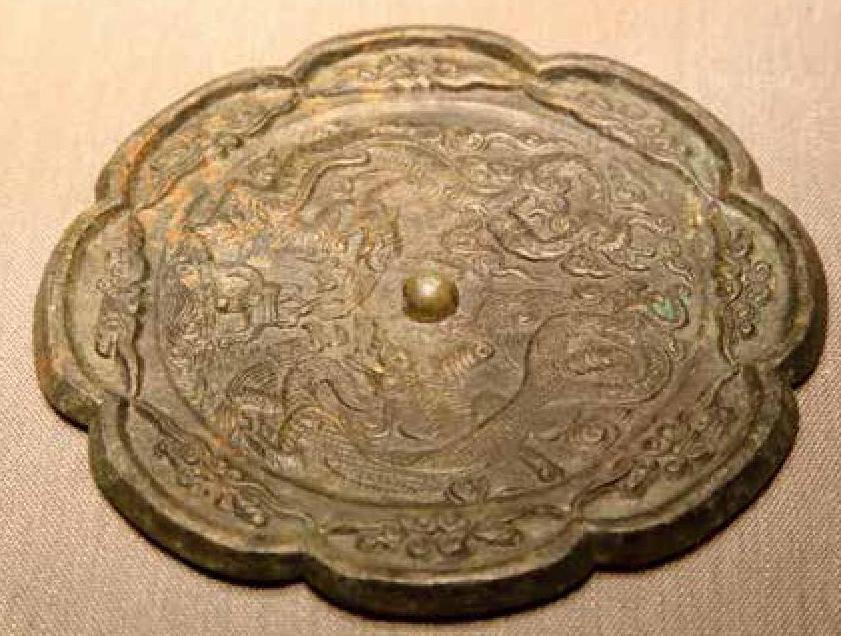一个展览里的南宋小日子
2020-03-16俞吉吉
俞吉吉

西溪湿地因为一句“西溪且留下”扬名中外,这句话正是宋高宗行经西溪欲建都于此时说的,“留下”这个浪漫的地名也由此而得。
西苑雅集,翩翩文人英辞秒墨,诗情画意;汴京郊外,绝世佳人骑马踏青,春意浓浓;勾栏瓦肆,歌舞升平,通宵不辍;市肆食店,集四海之奇珍,八荒之异味。历经三百多年的宋朝称得上是中国历史上最为繁荣、风雅的时代之一了。
西溪湿地因为一句“西溪且留下”扬名中外,这句话正是宋高宗行经西溪欲建都于此时说的,“留下”这个浪漫的地名也由此而得。西溪湿地隐藏了不少南宋的印记,中国湿地博物馆目前正在展出的“南宋记忆”主题展览将这些印记一一揭开,展现了当年南宋人过的精致小日子。展览将持续至2月29日。
文艺青年这样潮
喜欢慢生活的人,一定都去过网红地赏花拍照,打卡文创市集,其实南宋时期的文艺青年也一样。
京城临安就有花鸟市场,西溪地区是京城最大的花圃,尤其是花坞地区,堪称南宋的“网红花市”。现在西溪每年都举办的花朝节,从唐代就有了,到宋代达到鼎盛。南宋临安以2月15日為花朝节,百姓们会在自家庭院中的花枝上挂红绿绸布条,晚上则在花树上挂起“花神灯”。外地游客也会赶来参加西溪花朝节,堪比如今的国庆长假,是南宋临安的“旅游旺季”。
西溪灯会也是当时的一大盛会。南宋时期,西溪居民在祭祀林氏五庙之前,搭台唱戏,祈求来年丰收。最热闹的是龙灯、滚灯、狮子灯、马灯、花灯、拳灯这“六灯会”表演,放到现在,就相当于是迪士尼的花车巡游。
宋代人也养宠物,但当时流行的是养金鱼。据史料记载,杭州是金鱼的发源地。北宋时,大小佛寺中的放生池中已出现金鱼的影子。到了南宋,宋高宗赵构在兴建宫殿和园林的同时,专门放养了观赏金鱼,无意间引领了养金鱼的时尚。西溪的金鱼井,就是南宋时在此井中养金鱼,供高宗在前往洞霄宫途中观赏而得名的。
茶艺、茶花、香薰等,在宋代也一样受到文艺青年的追捧。煮茶、焚香、挂画、插花,被宋人合称为“四艺”。宋人喜爱簪花,从朝廷官员到平民百姓均有此爱好,甚至男子簪花也极为普遍,反映了当时人们普遍的生活状态和生活雅趣。看来,杭州人的慢生活,由来已久。展览现场就有南宋点茶体验和手工艺人古风花冠花簪制作,你可以在现场买一件来体验宋人簪花的美,再去新年祈福墙写一写新年愿望,许愿来年平安喜乐。
吃货们这样吃
民以食为天,宋代西溪的饮食文化发达到什么程度呢?
民间有“南柴北米,东菜西鱼”的俗谚,西溪是当时整个杭州水产市场的“活鱼库”,这里有极为完备、专业的贩鱼组织——鱼行。无论是河鲜水产的商贩还是老百姓都爱去市集买西溪的鱼虾,因为西溪的鱼特别好吃。为什么呢?这离不开西溪独有的天然良性可循环池塘生态系统——竹基、柿基和桑基鱼塘。
怎么吃鱼才最好吃?南宋人也有研究,发展出了船宴文化。上至帝王将相,下至文人骚客,无不以此宴食为上。文人墨客泛舟西溪水上,举盏交杯、品评美食。现在去西溪湿地,仍然保留了船宴的习俗,并进行了改良升级,游客可以坐着摇橹船穿行水上,品尝新鲜地道的西溪鱼火锅,体验一回南宋船宴。
宋代吃货也爱逛街,当时的商业街,一点都不比现在的差。分茶店、豝[bā]鲊[zhǎ]()店、南食店、凉水店、果子店、茶楼、油铺、汤店、药店、衣料店、胭脂铺、花朵铺、珠子铺、扇铺、漆器铺、瓷器铺、首饰作坊、书坊、质库、金银盐钞引交易铺……琳琅满目。
最好玩的是凉水店,原来南宋当时也流行甜品店。《西湖老人繁盛录》里记载了南宋临安的各种糖水,比如甘豆汤、椰子酒、卤梅水、木瓜汁、荔枝膏、梅花酒、五苓散、紫苏饮、皂儿水、绿豆水、乱糖真雪、富家散暑药冰水、豆儿水、姜蜜水、沉香水、苦水、金橘水、香薷饮等等。这里面的西溪必吃榜单上必定有梅花泉酒。西溪水质上乘,适宜酿酒,酿酒业是西溪市镇的主要产业。南宋时西溪酒库所酿的酒名为“梅花泉酒”,水源来自西溪之北柏家园左的梅花泉,其酒由此得名。
当然,街上也有西溪库这样的大酒楼,地位堪比如今的楼外楼。锦丝头羹、四软羹、二色腰子、盐酒腰子、鸡丝签、鹅粉签、蒸软羊、羊蹄笋、五味炙小鸡、假炙江瑶肚尖、香螺脍、鹌子水晶脍、酒法青虾、生烧酒蛎、水龙虾鱼、蟹酿橙、银鱼炒鳝、蚶子明芽肚、蛤蜊淡菜、米脯风鳗……特色菜品光是看看菜单就让人垂涎。
运动达人这样玩
宋室南渡后,汴京许多风俗被带到临安,龙舟竞渡承汴京金明池遗风,盛况空前。南宋杭州的赛龙舟一年有两次,一次在二月初八开始,一直延续到清明;另一次在端午前后,自五月初一至初十。西溪赛龙舟始于唐代,兴盛于南宋。如今,从西溪端午节龙舟胜会中的满天幛龙舟身上,就可以窥见南宋龙舟之遗韵。
养鸟、斗蟋蟀、斗蚁蔚然成风,相扑、弈棋、蹴鞠、打球成了全民运动。南宋市民精神文化和娱乐生活之丰富,大大超越了之前的朝代。
南宋,是斗蟋史上最著名的时代。都城内的市井坊巷里随处可见斗蟋蟀、对弈的小摊,百姓们围得密不透风,拍手叫好。《西湖老人繁盛录》记载:“促织()盛出,都民好养,或用银丝为笼,或作楼台为笼,或瓦盆竹笼,或金漆笼、板笼甚多。每日早晨,多于官巷南北作市,常有三五十人火斗者。”
此次“南宋记忆”展览中还有捶丸、投壶体验。
捶丸,是中国古代汉族球戏之一。前身是唐代马球中的步打球。到了宋朝,步打球由原来的同场对抗性竞赛逐渐演变为依次击球的非对抗性比赛,球门改为球穴,名称也随之改称为“步击”“捶丸”。
投壶则是从先秦延续至清末的中国传统礼仪和宴饮活动。宴请的时候,如果主人家庭院不够宽阔,不足以张侯置鹄,或者由于宾客众多,不足以备弓比耦,又或是有的宾客的确不会射箭,这时候玩一局趣味性十足的投壶来代替弯弓射箭,既活跃了宴席氛围,又不会让嘉宾尴尬,大可以乐嘉宾、以成礼仪。
Memory of the Southern Song, an exhibition on the lifestyle of the dynasty centered in Hangzhou (called Linan back then), is now ongoing till February 29 at China Wetlands Museum in Hangzhou.
The Southern Song (1127-1279) represents the best years Hangzhou had ever seen in the feudal era. Thanks to detailed historical records and books written during or shortly after the dynasty, we now know a great deal about cultural activities people had back then.
One of the entertainment and recreation centers of the capital city was West Creek, which was several kilometers outside the walled city in the past and is now hemmed in by the urban sprawl of Hangzhou. The name is still in use today. The creek area is now a national wetland park, which preserves the pristine wetland and the rural lifestyle that has been around for more than 1,000 years. Back in the Southern Song, West Creek was as famous as the West Lake as a tourist attraction for people in the city.
A large part of the exhibition is about the leisure lifestyle of West Creek.
The capital city had a market for flowers and pet birds. West Creek housed the citys largest flower nursery. The Flower Festival, now held annually at West Creek, can be traced back to the Tang Dynasty (618-907). The celebration of the annual festival thrived in the Southern Song on February 15th on the lunar calendar. West Creek Lantern Festivities were a popular attraction on a day that local residents held a public sacrifice ceremony at five temples in honor of their ancestors. Among these festivities was a grand lantern parade.
In the Song Dynasty, people loved pets. The most popular pet was goldfish. According to history, Hangzhou was where golden fish was first cultivated. In the Northern Song (960-1127), religious temples across the country had goldfish in their ponds where disciples let go captive fish and turtles, etc. In the Southern Song, Emperor Zhao Gou had a goldfish pond in the Forbidden City. Goldfish Well in West Creek is said to have been built so that the emperor could stop there to view goldfish in the well on his way to visit the Dongxiao Temple.
Tea, flower and scented incense were popular fashions in everyday life of local people in the Song Dynasty. Many people including government officials wore flowers on “the lapel of their suit”, so to speak. If the statement that life in Hangzhou is fascinatingly and luxuriously slow is true, this seemingly leisure can at least be traced back to the Southern Song.
West Creek used to be the fish tank for the citys fish market simply because there were high-quality fish ponds in West Creek. Taking a pleasure boat tour and having a fish banquet on the boat in West Creek where rivers and ponds were numerous was a must-have experience for royal visitors and common people. A fish banquet on a pleasure boat is available today for tourists to the West Creek.
The capital city offered shopping streets where separate shops combined to serve as a department store. A look at a list of all the businesses there would make one wonder how life was good and colorful and fancy back then. For example, the sweet beverage shop offered a great variety of sugared soft drinks. Many were fruit drinks and many were herbal drinks. Another big pillar of West Creeks economy was wine making thanks to the high-quality water. The West Creek had many grand restaurants. The menus of these restaurants look mouthwatering even today.
When the Northern Song crashed, the royal house fled the north and set up the Southern Song in Linan (present-day Hangzhou), followed by a great number of people. The northern lifestyle was brought over to the south. “Dragon boat racing” was an event that carried the tradition of the northern even though the race started in the Tang Dynasty in West Creek. In West Creek, dragon boat racing was held twice a year. The first race started on the 8th day of the lunar February till the Qingming Festival in early April. The second race lasted 10 days from May 1 to 10 on the lunar calendar in celebration of the Duanwu Festival which occurs on the fifth day of the lunar May.
In addition to hobbies such as keeping pet birds, cricket fighting, ant fighting, sporting games such as wrestle, football, and chess were popular in the Southern Song Dynasty.
